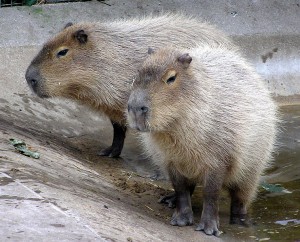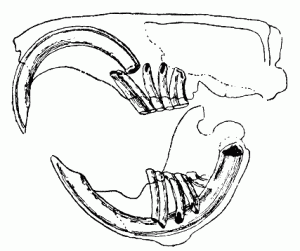In number of species rodents make up the largest order of mammals, and are found on every continent except Antarctica. With about 2,277 species of rodents, over 40% of mammalian species belong to the order Rodentia. They are characterised by a single pair of continuously growing incisors in both the upper and lower jaws which must be kept short by gnawing.
Some rodents commonly kept as pets include chinchillas, mice, rats, guinea pigs, gerbils, and hamsters. Wild rodents not commonly seen as pets, aside from the wild versions of mice and rats, include squirrels, beavers, muskrats, chipmunks, voles, and capybaras (pictured above), which are the largest living rodents, weighing in at up to 91 kg (200 lbs). Animals such as bats, shrews, moles, rabbits, hares, and pika are often confused with rodents but are all actually members of non-rodent orders. Most rodents eat seeds or plants, though some have more varied diets, including insects and scavenging on dead animals. Some species have historically been considered pests, eating food stored by people and spreading disease.
Their success is probably due to their small size, their short breeding cycle, and their ability to eat a wide variety of foods.
Dentition
Typical rodent tooth structure:
Nearly all rodents share a characteristic dentition highly specialized for gnawing, which gives rodents their name from the Latin, rodere, to gnaw. Typically rodents have a single pair of upper and a single pair of lower incisors, followed by a gap and then one or more molars or premolars. Usually rodent incisors grow continuously and must be kept worn down by gnawing. Their front and side surfaces are covered with enamel, but the rear surface is exposed dentine; during gnawing the incisors grind against each other, wearing away the softer dentine, leaving the enamel edge sharp as the blade of a chisel. This ‘self-sharpening’ system is very effective and is one of the keys to the enormous success of rodents. Rodents do not have canines. Nearly all rodents feed on plants, seeds in particular, but a few exceptions eat insects or fish. Some squirrels are known to eat birds.
Evolution
Several truly enormous rodents are known from the fossil record, the largest being Josephoartigasia monesi, which is estimated to have generally weighed about 1,000 kg (2,200 lb), and possibly up to 2,586 kg (5,700 lb) in large individuals. The fossil record of rodent-like mammals begins shortly after the extinction of the dinosaurs 65 million years ago, as early as the Paleocene. Some data, however, suggest modern rodents (members of the order Rodentia) had already appeared in the late Cretaceous. By the end of the Eocene epoch, relatives of beavers, dormice, squirrels, and other groups appear in the fossil record.



mugs!
This is heavy, heavy rodent
-moustress
Hey Mugs, glad you still have petrodents!
I like the new platform, like a blog.
Guppie51
Thanks! Glad to hear you’re still kicking around! Love your latest work (yes, I lurked your website).
The spambots and trolls got to be too much for me, so I converted the thing to WordPress, and tried to salvage as much of the good stuff as I could. Still a bunch I’d like to rescue from the backup of the old forum, but that’s for another day.
Guppie! 51! so glad to see you here!
Kimsgerbils here! Guess old habits die hard 🙂
The ol’ gang is coming back together! 😀
Holy crap I had no idea this place was even still around. Last time I visited, aol was relevant, Bush was president, and I hadn’t hit puberty.
Yep, still chugging along, although in a revised form. 🙂 The forum was totally overrun by porn and spambots, so I had to take it down, but I didn’t want to lose all the valuable information that we’d collected.
Hope things are going well with you!
There’s still a bit of a community here; we should try to revive this forum.